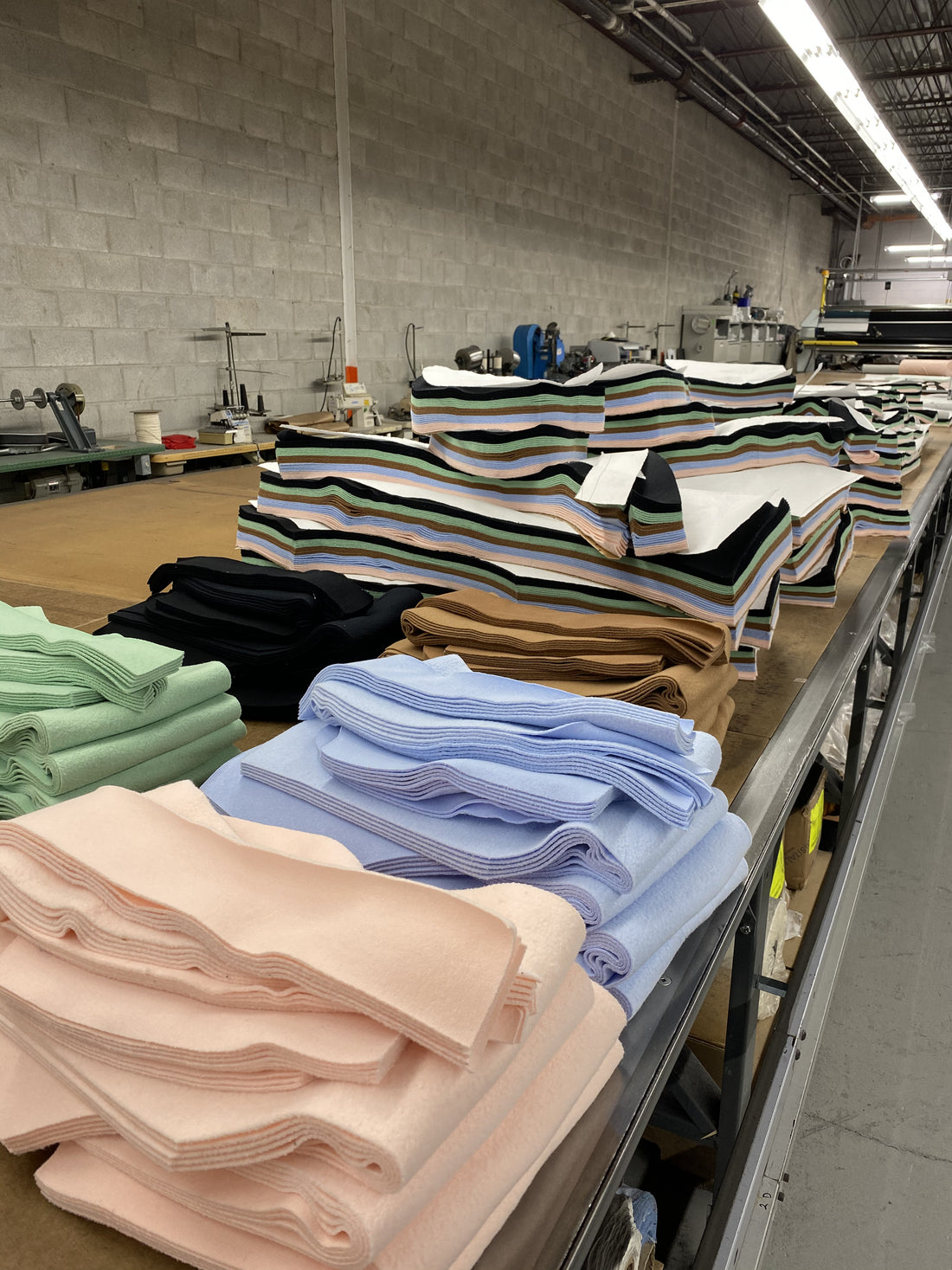
Pattern Making Explained: A Guide to Clothing Design and Production
Share
Pattern making is an essential part of the clothing manufacturing journey. It's the stage in clothing production stage which bridges design conceptions into feasible blueprints that can be made at scale.
Innovative designs might captivate consumers' attention, but pattern making translates these designs into wearable art. It ensures the garment fits as intended, looks symmetrical, and uses materials efficiently, a crucial factor in managing production costs.
In short, good pattern making is the cornerstone of good clothing design. And clothing startups that neglect this step risk compromising their final product, potentially leading to wastage, increased costs, and customer dissatisfaction.
Understanding The Basics of Pattern Making
Defining the Key Terms of Pattern Making
As you delve into pattern making, the first important step is to understand key terms. Knowing these terms will help you have a basic grasp of the technical steps of pattern making and facilitate better communication with your manufacturer.
Here's a brief glossary to get you started:
-
Sloper: A sloper, also known as a basic block or master pattern, is a foundational template devoid of style elements. It's a basic 2D pattern that fits the body (or dress form) accurately without any design features or seam allowance. Slopers are used as the starting point to develop more intricate patterns with unique designs.
-
Block Pattern: Another term for a sloper, a block pattern is a foundational pattern from which other designs can be developed. In clothing manufacturing, block patterns are often used to maintain consistency in fit and size across various designs.
-
Grading: Grading is the process of resizing a base pattern into different sizes while maintaining shape, fit, balance, and scale of style details. It's critical for clothing startups seeking to offer their designs in a variety of sizes.
-
Ease: Ease is the extra space in a garment that allows for movement and a comfortable fit. It's important to apply the correct amount of ease to ensure the garment fits well but also provides sufficient room for the wearer to move.
Essential Tools for Pattern Making
The tools of pattern making are as vital as the process itself. A pattern maker's kit typically includes a pattern ruler, measuring tape, tracing wheel, pattern notcher, scissors, and pattern paper. These tools allow for accurate measurements, pattern drafting, and modifications, thereby ensuring a perfect fit. Digital tools, including computer-aided design (CAD) software, are also becoming prevalent in modern pattern making. Such software simplifies the design process, allowing for precision and easy adjustments.
The Role of Pattern-Making in the Clothing Manufacturing Process
Once a design concept is established, pattern making translates this vision into a concrete plan for production. It's where the technical specifications for a garment—like dimensions, shapes, and seam allowances—are determined and set into a pattern.
For clothing startups, pattern making serves a pivotal role. It aids in maintaining a standard fit across different sizes, ensuring the consistent quality of the produced garments. A well-executed pattern can streamline the production process, reducing fabric waste and enhancing efficiency. Moreover, pattern making can influence the cost-effectiveness of production, making it a critical consideration for startups working within tight budgets.
Pattern Making Techniques
Drafting
Drafting involves creating a pattern from scratch, using a set of precise measurements taken from a fit model or dress form. A pattern drafter uses these measurements to sketch the outline of a garment directly onto pattern paper.
A well-drafted pattern ensures the design stays true to its intended fit and style, ultimately leading to a superior end product.
Draping
Draping involves pinning, shaping, and smoothing a piece of fabric onto a dress form to create a three-dimensional model of the design. Once the desired fit and drape are achieved, the fabric is carefully removed, marked, and flattened to create a pattern.
Clothing startups may find draping advantageous when working with unique or complex designs. This method allows for immediate visualization and tactile interaction with the garment, facilitating instant modifications and creativity in design.
Flat Pattern Making
Flat pattern making is a technique that manipulates a basic sloper or block pattern to create a new design. This method is quicker and more efficient than drafting or draping, making it a popular choice for clothing startups. By adjusting different elements of the sloper—such as dart placement, fullness, and length—various designs can be generated without compromising fit.
Computer-Aided Design in Pattern Making
Computer-aided design (CAD) is revolutionizing the traditional pattern making process. CAD systems enable pattern makers to create, adjust, and finalize designs with enhanced accuracy and speed. With this technology, manual tasks like drafting, grading, and marker making can be automated, saving time and reducing errors.
For clothing startups, CAD in pattern making presents opportunities for increased productivity, precision, and consistency. Moreover, it allows for easy storage and modification of patterns, offering flexibility and convenience. The rise of CAD doesn't mean manual pattern making skills are obsolete; rather, it suggests that a blend of traditional skills and modern technology can lead to optimal results in clothing manufacturing.
The Role of Technology in Pattern Making
The Advent of Digital Pattern Making
The digital revolution has swept across various industries, and clothing manufacturing is no exception. In pattern making, technology introduces new possibilities for precision, efficiency, and creative exploration. Digital pattern making employs software to create, alter, and perfect patterns, reducing the manual labor and time required in traditional methods.
Digital pattern making is a game-changer. It offers unparalleled precision, ensuring that patterns are accurate to the last millimeter. It also promotes efficient alterations, enabling designers to tweak and finalize patterns with a few clicks. Moreover, digital platforms facilitate easy pattern storage and sharing, streamlining the design process.
Computer-Aided Design (CAD) Systems in Pattern Making
Computer-aided design (CAD) systems have become an invaluable tool in the modern pattern making process. These software solutions enable designers to draft and edit patterns, grade sizes, and plan garment layout on fabric—all digitally. With CAD, errors can be instantly corrected, and pattern modifications can be done with ease, promoting efficient and precise pattern creation.
Clothing startups investing in CAD technology gain a competitive edge. It allows for streamlined production, higher precision, and reduced wastage—contributing to cost efficiency. Furthermore, CAD systems cater to mass production, an essential factor for startups looking to scale their operations.
Pattern Making for Different Clothing Types
Pattern Making for Dresses (Expand in Revision)
Creating patterns for dresses is a meticulous task that demands a keen understanding of body proportions, style elements, and fabric properties. It begins with drafting or modifying a basic dress block, adjusting elements like the waistline, neckline, and sleeve style according to the design. Whether it's an A-line dress, a bodycon dress, or a maxi dress, each style necessitates unique pattern adjustments.
For clothing startups specializing in dresses, mastering these nuances can significantly elevate the fit and appeal of their products. A well-structured dress pattern can translate into an end product that flatters various body shapes and sizes, broadening the brand's appeal.
Pattern Making for Shirts
Shirt patterns require special attention to details like collar style, button placket, cuffs, and yoke. The process often starts with a basic shirt block, which is then manipulated to incorporate design features. Precision in drafting collar and cuff patterns is particularly crucial as these areas greatly influence the fit and comfort of the shirt.
Shirt-focused clothing startups must understand these specifics to ensure their products offer a comfortable fit and a polished appearance. A well-executed shirt pattern can create a garment that seamlessly blends functionality and style.
Pattern Making for Pants
Pants pattern making involves detailed consideration of elements like the waistband, fly, and the curve of the hip and crotch areas. Starting with a basic pants block, the pattern maker adjusts for various styles—be it straight-leg jeans, wide-leg palazzo pants, or fitted leggings.
For clothing startups venturing into pants production, getting the pattern right is vital. It not only dictates the fit of the pants but also impacts the wearer's comfort and movement. The right pattern can make the difference between pants that sag and bunch, and a pair that provides a smooth, flattering fit.
Pattern Making for Outerwear
Outerwear pattern making can be more complex, considering the layering factor and the need for elements like linings, zippers, buttons, and possibly hoods. The base pattern for outerwear—whether it's a blazer, a winter coat, or a lightweight jacket—needs to account for additional ease to accommodate clothing worn underneath.
Outerwear-focused clothing startups need to master the intricacies of these patterns. This understanding can help produce outerwear that is not only aesthetically pleasing but also functional, warm, and comfortable, ultimately leading to a product range that resonates with discerning customers.
Common Challenges in Pattern Making and How to Overcome Them
Achieving Accurate Fit
One of the primary challenges in pattern making is achieving an accurate fit. Misjudged measurements or minor errors in drafting can result in ill-fitting garments that are uncomfortable for the wearer.
For clothing startups, precision in pattern making is paramount. Investing time in taking accurate body measurements and meticulously transferring these onto the pattern is a must. Regular fit testing on a dress form or fit model is also essential to ensure the accuracy of the pattern. Employing grading techniques can help produce a well-fitting garment across different sizes.
Balancing Design and Functionality
Striking a balance between design and functionality can be challenging in pattern making. While unique and intricate designs are desirable, they should not compromise the garment's wearability and comfort.
To overcome this, clothing startups should maintain a design process where aesthetics and functionality go hand in hand. Detailed technical sketches can help visualize how a design translates into a garment. Furthermore, prototyping or sample making allows for early detection and rectification of any design elements that might hinder functionality.
Fabric Waste Minimization
Fabric waste is a persistent issue in pattern making. Poorly planned patterns can lead to inefficient fabric use, driving up production costs and contributing to environmental waste.
To address this, clothing startups can employ thoughtful pattern layout techniques and use software for efficient marker making, ensuring maximum fabric utilization. Utilizing zero-waste design strategies, where the pattern pieces fit together like a puzzle, leaving no fabric unused, can also significantly reduce waste.
Scaling Production
Scaling production can present challenges in pattern making. As a clothing startup grows, producing larger volumes while maintaining consistent quality becomes crucial.
Implementing a robust grading system is essential for scaling. This enables patterns to be accurately resized, ensuring consistent fit across different sizes. Computer-aided design (CAD) tools can facilitate this process, ensuring precision and efficiency. Additionally, a well-documented pattern making process can streamline production, reducing errors and enhancing consistency as the volume of production increases.
Wrapping Up
For clothing startups, developing a solid foundation in pattern making is crucial. It's a complex process that requires precision, creativity, and a deep understanding of both the design and the wearer.
Quality pattern making is the difference between producing a garment that merely looks good on the rack, and one that fits and feels great to wear, appealing to discerning customers and setting the brand apart in the competitive fashion industry.
Creating patterns for different clothing types—dresses, shirts, pants, and outerwear—each poses its unique challenges and requires special considerations. Knowledge and expertise in these areas can help startups cater to a diverse range of styles and consumer preferences, broadening their market appeal.
With the insights and guidelines provided in this guide, we hope to have offered a solid starting point for startups venturing into the world of pattern making. Here's to creating garments that not only look great but feel great, one pattern at a time.
